How to Make Boba Tea Without Tapioca Pearls: Creative Alternatives & Tips!
You can make delicious boba tea without tapioca pearls by using alternative ingredients like fruit jellies or popping boba. This twist on the classic drink allows you to enjoy all the flavors and textures of traditional bubble tea while skipping the chewy pearls.
Whether you’re avoiding tapioca due to dietary restrictions or simply want to try something new, this guide will help you craft a refreshing beverage that’s just as satisfying.
Key Takeaways
- Alternative Ingredients: You can enjoy boba tea without tapioca pearls by using substitutes like popping boba, sago, mochi, pudding, and grass jelly for unique textures and flavors.
- Base Tea Options: Choose from various base teas such as black tea, matcha, fruit teas, or herbal teas to create your desired flavor profile.
- Sweeteners Enhance Flavor: Experiment with different sweeteners like brown sugar, honey, maple syrup, coconut nectar, vanilla extract, or cinnamon to customize the sweetness of your drink.
- Simple Preparation Steps: Brew your chosen tea strong enough to balance with ice and milk; cool it down before mixing in milk and sweetener for a refreshing beverage.
- Creative Toppings: Incorporate fun alternatives like agar boba, fruit jelly cubes, coconut gel chunks, or popping pearls to elevate your boba tea experience without traditional tapioca pearls.
Overview of Boba Tea Alternatives
Boba tea can be made without tapioca pearls by using various substitutes that provide a similar texture and taste. Here are some popular options:
- Popping Boba: Popping boba consists of small, chewy balls filled with flavored juice. Made from sodium alginate, these add a fun burst of flavor to your drink.
- Sago: Sago is derived from the pith of palm trees and comes in small, round shapes after cooking. It offers a chewy texture that resembles tapioca pearls.
- Mochi: Mochi is a rice flour-based dough commonly used in Japanese cuisine. When shaped into small balls and cooked, it provides a soft yet chewy addition to your boba tea.
- Pudding: Many shops include pudding as an alternative topping for boba tea. This creamy option gives you a smooth mouthfeel without needing tapioca pearls.
- Grass Jelly: Grass jelly is made from the mesona plant leaves, offering a unique chewy texture and slightly herbal taste when added to drinks.
These alternatives allow you to enjoy boba tea while experimenting with different flavors and textures to suit your preferences or dietary needs.
Ingredients Needed for Boba Tea
Base Tea Options
- Black Tea: This classic choice offers a strong flavor, perfect for traditional boba tea.
- Matcha: A green tea powder that adds a unique taste and vibrant color to your drink.
- Fruit Teas: Options like strawberry or mango provide fruity flavors, making your boba tea refreshing.
- Herbal Teas: Varieties such as hibiscus bring floral notes and caffeine-free options.
- Brown Sugar: Use 3 tablespoons per cup of tea for rich sweetness.
- Honey: A natural sweetener that adds a distinct flavor.
- Maple Syrup: Offers a different kind of sweetness with an earthy taste.
- Coconut Nectar: Provides a hint of caramel flavor while being lower on the glycemic index.
- Vanilla Extract: Enhances the overall taste with its warm notes.
- Cinnamon: Adds warmth and spice, perfect for those who enjoy bold flavors.
Steps to Make Boba Tea Without Tapioca Pearls
Making boba tea without tapioca pearls involves simple steps. Follow these methods to create a delicious drink.
Preparing the Base Tea
- Brew the Tea: Start by brewing a strong tea base. You can use black tea, green tea, or herbal tea. For a classic flavor, brew double-strength to balance with ice and milk added later.
- Cool the Tea: Once brewed, let the tea cool to room temperature or refrigerate it until chilled.
- Add Milk: Choose your preferred type of milk, such as whole milk or non-dairy options like almond or oat milk. Sweetened condensed milk adds extra sweetness if desired.
- Add Sweetener: Enhance flavor with sweeteners like simple syrup, brown sugar syrup, or honey. Fruit-flavored syrups work well for variety.
- Combine and Serve: Mix cooled tea with chosen milk and sweetener in a glass filled with ice. Use a boba straw for easy sipping, and consider adding toppings like fruit pieces or whipped cream for more texture.
Creative Alternatives to Tapioca Pearls
You can create boba tea without traditional tapioca pearls by using various alternatives that add a chewy texture and unique flavors. Here are some options to consider:
Agar Boba
The Agar boba serves as an excellent substitute for tapioca pearls. Agar, derived from red algae, has a gelatin-like consistency. It absorbs flavors well, making it perfect for bubble tea.
You can easily prepare agar boba by dissolving agar powder in hot water and mixing with your favorite juice or syrup for taste. Once cooled, cut the mixture into small pieces similar to tapioca pearls.
Fruit Jelly Cubes
Fruit Jelly Cubes provide a delightful twist on classic boba tea. Made with grass-fed gelatin, water, honey, and fruit juice, these cubes offer both flavor and texture. To create them, mix the ingredients and pour the mixture into molds.
After refrigeration until firm, slice them into straw-friendly pieces before adding them to your drink. These jelly cubes not only look appealing but also add a healthy element to your beverage.
Coconut Gel Chunks
Coconut gel chunks make another fantastic alternative to tapioca pearls. These chunks have a chewy texture comparable to pearls while providing a subtle coconut flavor that complements many teas.
You can find pre-made coconut gel at Asian grocery stores or make your own by mixing coconut water with agar or gelatin.
Popping Pearls
Lastly, popping pearls offer an exciting experience in every sip of your boba tea. These small spheres have thin skins filled with flavored liquid that burst when bitten into them.
They come in various flavors like mango and passionfruit—perfect for adding vibrancy and fun to your drink.
Each of these alternatives brings something special to your boba tea experience while keeping it deliciously enjoyable without traditional tapioca pearls.
Conclusion
Exploring alternatives to tapioca pearls opens up a world of delicious possibilities for your boba tea.
Whether you prefer the fruity burst of popping boba or the chewy texture of mochi, there’s something that can cater to your taste buds. Customizing your drink with different teas and sweeteners adds another layer of enjoyment.
Don’t hesitate to experiment with various ingredients to create a unique blend that suits your preferences.
With these creative options at your disposal, you can enjoy boba tea that’s just as satisfying without traditional tapioca pearls. Get ready to sip on something extraordinary and make every cup truly yours!
Frequently Asked Questions
What are some alternatives to tapioca pearls in boba tea?
You can try fruit jellies, popping boba, sago, mochi, pudding, and grass jelly as alternatives. Each option offers unique textures and flavors that can enhance your boba tea experience.
What types of base tea can I use for boba tea?
Popular base teas include black tea, matcha, fruit teas, and herbal teas. Each type provides a distinct flavor profile that complements the toppings you choose.
How can I customize my boba tea?
Customization options include selecting different sweeteners and flavor enhancers to suit your taste preferences. You can also mix various toppings for a unique combination.
What is agar boba?
Agar boba is a gelatinous alternative made from seaweed extract. It provides a chewy texture similar to traditional tapioca pearls but is vegan-friendly.
Are there any tips for perfecting my boba tea at home?
To perfect your boba tea, focus on brewing high-quality tea, balancing sweetness levels carefully, and experimenting with different toppings to find your favorite combinations.






